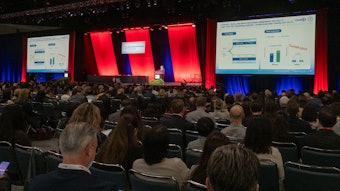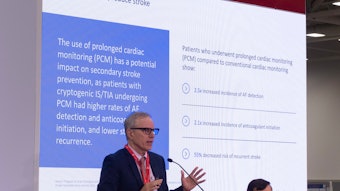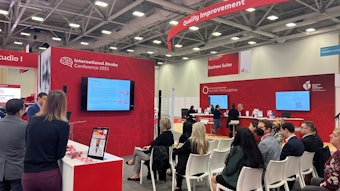Late breakers report on DOACs reducing ischemic stroke risk, thrombolysis with tenecteplase following successful thrombectomy and more

 Zhu
Zhu
- Direct oral anticoagulation reduced the risk of ischemic stroke in intracerebral hemorrhage survivors with atrial fibrillation, and despite a higher risk of recurrent ICH, yielded potential net clinical benefit.
- Thrombolysis with tenecteplase after thrombectomy improved large vessel occlusion stroke outcomes.
- DATE trial explores safe tenecteplase dosing after thrombectomy.
- ETERNAL-LVO trial of 24-hour time window for tenecteplase was halted early.
- Alteplase is safe and effective at least 24 hours after the patient was last known to be well.
- Thrombolysis with alteplase after thrombectomy improved LVO stroke outcomes.
- Dual antithrombotic therapy offered no benefits for patients with AFib plus ASCVD.
- Liraglutide reduced recurrent stroke in patients with minor ischemic stroke and type 2 diabetes.
- A novel neuroprotective agent showed promise in a phase 2 trial.
DOACs reduced ischemic stroke risk in patients, but they may have increased the risk of recurrent ICH. Net clinical benefit uncertain.
The PRESTIGE-AF trial showed that direct oral anticoagulants (DOACs) reduced the risk of ischemic stroke by 95% for intracerebral hemorrhage (ICH) survivors with atrial fibrillation. DOACs also boosted the risk of recurrent ICH by nearly 11-fold. Composite endpoints suggested a quantitative net benefit of DOACs, but a different impact of particular events (ischemic stroke versus ICH) still has to be considered.
Stroke prevention in ICH survivors is a critical unmet need, said Roland Veltkamp, MD, professor of neurology and chair of stroke medicine at Imperial College London. Survivors have an increased risk of ischemic events as well as higher risk for recurrent ICH. Survivors with concomitant AFib are a particularly vulnerable population, with markedly increased risk for both ischemic events and recurrent ICH.
Veltkamp noted that PRESTIGE-AF, a phase 3b randomized trial, was the first trial comparing DOACs to no oral anticoagulation (OAC), with or without antiplatelet therapy in ICH survivors with AFib. Veltkamp
Veltkamp
The trial was conducted at 75 centers across six European countries. From May 2019 to November 2023, 319 patients were enrolled and were followed for a mean of 1.43 years. Of the group, 158 were randomized to DOACs (primarily apixaban, dabigatran, rivaroxaban or edoxaban) and 161 to no anticoagulation, aspirin or clopidogrel. The median age of patients was 78, 35% were female, and 95% self-reported as white.
The co-primary endpoints were first ischemic stroke and first recurrent ICH. Key secondary endpoints included all-cause mortality, cardiovascular mortality, major adverse cardiac events, any ICH and any major bleeding. Composite endpoints were all stroke and systemic embolism and net clinical benefit, defined as all stroke and systemic embolism, myocardial infarction, cardiovascular mortality and major bleeding.
The DOAC group had one ischemic stroke versus 20 events for the no-anticoagulation group, demonstrating clear superiority, HR 0.05 (95% CI 0.01-0.36, p<0.001). However, the DOAC group had a significantly higher rate of recurrent ICH, HR 10.9 (95% CI 1.95-60.72, p=0.961), failing to meet noninferiority.
The DOAC group showed a net clinical benefit HR of 0.67 (95% CI 0.33-1.36). Veltkamp said secondary findings should be interpreted with caution due to wide confidence intervals. Investigators calculated a number needed to treat of 13 to prevent one ischemic stroke per year. The number needed to harm — to cause one additional ICH per year — was 24.
“DOACs effectively reduced the risk of ischemic stroke and of other ischemic events in PRESTIGE-AF, consistent with previous randomized data,” Veltkamp said. “A part of this benefit was offset by major bleeding side effects in DOACs. We are waiting for the data from large, ongoing phase 3 trials to further clarify the net benefit of DOACs.”
Thrombectomy plus tenecteplase improves LVO stroke outcomes
Thrombolysis with tenecteplase following successful thrombectomy for acute large vessel occlusion (LVO) stroke improved the likelihood of excellent neurological outcome at 90 days by 44% compared to the standard care group, the ANGEL-TNK trial found. Researchers surmised that thrombectomy restored large vessel circulation while thrombolysis improved circulation in smaller vessels and microcirculation. Historical data suggest that about half of patients with LVO stroke treated with thrombectomy alone are disabled or dead at 90 days. Hou
Hou
“This clinical trial tests whether delivering tenecteplase directly into the affected artery after endovascular treatment can break up blood clots in the small vessels and improve blood flow, reducing the amount of brain tissue that lacks blood supply,” said Xiaochuan Huo, MD, PhD, director of the neurological disease center at Beijing Anzhen Hospital.
ANGEL-TNK — a prospective, open-label, blinded endpoint trial — randomized 256 patients with LVO stroke following successful endovascular recanalization to either intra-arterial tenecteplase (127 patients) or standard medical care (129 patients). Patients’ median age was 71, and 45% were female. The trial was conducted at 19 centers across China from January 2023 to March 2024. All patients were treated between 4.5 and 24 hours after last known well, and none had received thrombolysis before endovascular therapy.
The primary outcome was the percentage of patients with modified Rankin Scale (mRS) scores of 0-1 at 90 days. The primary safety outcomes were intracranial hemorrhage within 48 hours of treatment and all-cause mortality at 90 days.
More patients in the tenecteplase group had mRS scores of 0-1 at 90 days compared with the standard care group, 40.5% versus 26.4% (95% CI 1.06-1.95, p=0.02). There was no significant difference in symptomatic intracranial bleeding at 48 hours, 5.6% for the tenecteplase group and 6.2% for standard care (p=0.92). All-cause mortality at 90 days was likewise similar: 21.4% for the tenecteplase group and 21.7% for the standard care group (p=0.39).
“Intra-arterial tenecteplase after successful thrombectomy could improve the percentage of people with an excellent outcome,” Huo said. “It could also improve the rate of large vessel occlusion stroke survivors who can return to society and live independently.”
Observation is continuing to assess one-year outcomes. Huo said longer-term results could influence treatment guidelines for LVO stroke patients following successful thrombectomy.
DATE trial explores safe tenecteplase dosing after thrombectomy
Multiple trials have demonstrated the safety of intra-arterial tenecteplase following successful thrombectomy, but dosing has been based on trial steering committee recommendations or fractions of intravenous alteplase. What may be the first systematic dose escalation study of tenecteplase, a trial called DATE, suggested optimal dosing of 0.03125 mg/kg or 0.0625 mg/kg are safe following endovascular thrombectomy within 24 hours of stroke symptom onset, but efficacy could not be conclusively established.
“Because of the limitations in the study size and scope, the efficacy of these doses is not definitive,” said Xianhua Hou, MD, department of neurology, Southwest Hospital of Army Medical University, Chongqing, China. “Further validation through larger studies is necessary to assess the potential therapeutic benefit and refine the optimal dose to improve clinical outcomes.”
Hou said the DATE trial grew from the recognition that about half of patients do not achieve functional independence following thrombectomy. One reason, Hou said, is lack of reperfusion in the microcirculation, the no-reflow phenomenon that is seen in about a third of patients following successful macrovascular reperfusion.
Adding thrombolysis after thrombectomy can improve outcomes by reducing no-reflow. Tenecteplase has a longer half-life than alteplase and higher fibrin specificity, Hou said, suggesting it may be the preferable agent. But previous clinical trials have tested doses ranging from up to 4.5 mg as a fixed dose to weight-based dose s of 0.0625 mg/kg and 0.125 mg/kg.
“There is an urgent need to determine which dose provides the best balance of efficacy and safety,” Hou said.
The DATE study — an open-label, randomized, multicenter phase 1b/2a trial — was conducted in 30 centers in China from June 2023 to August 2024. Phase 1b randomized 48 patients with acute ischemic stroke to tenecteplase doses starting at 0.03125 mg/kg and escalating to 0.125 mg/kg. Dose toxicity was assessed based on symptomatic intracranial hemorrhage within 24 hours.
Phase 2a randomized 157 new patients, 46 patients into each of two dosing groups and 65 patients into a control group. The primary efficacy outcome was mRS score of 0-1 at 90 days. Primary safety outcomes were symptomatic intracranial hemorrhage within 24 hours and all-cause mortality at 90 days.
Phase 2a patients had a median age of 71 years old, and 44.3% were female.
Phase 1b stopped escalating doses at 0.125 mg/kg due to unacceptable rates of symptomatic intracranial hemorrhage, and the two lower doses, 0.03125 mg/kg and 0.0625 mg/kg, were selected for phase 2a. The latter phase showed higher mRS scores for both doses versus control, but there were no statistically significant differences between the three groups.
Extended-time window trial for tenecteplase halted early
The ETERNAL-LVO trial of tenecteplase up to 24 hours after large vessel occlusion stroke was halted early in April 2024 due to low recruitment secondary to the COVID-19 pandemic, drug supply problems and an emerging lack of equipoise in the 0 to 4.5- hour treatment window. A subanalysis of the per-protocol population showed tenecteplase may have improved 90-day outcomes for patients transferred from an acute stroke center to a comprehensive stroke center, but overall results showed no benefit. The trial enrolled 244 of a planned 740 patients. Yogendrakumar
Yogendrakumar
“We found no major difference between tenecteplase for patients with large vessel occlusion stroke compared to standard care in terms of modified Rankin Scale (mRS) score at 90 days,” said co-principal investigator Vignan Yogendrakumar, MD, PhD, assistant professor of medicine at the University of Ottawa and associate scientist at Ottawa Hospital Research Institute Neuroscience Program in Ontario. “We did not see any major differences in rates of symptomatic intracranial hemorrhage or all-cause mortality between the two groups.”
Yogendrakumar noted that when ETERNAL-LVO was launched in 2020, there were no clear data comparing tenecteplase and standard care for large vessel occlusion stroke. More recent trials confirm non-inferiority for tenecteplase versus alteplase as late as nine hours from stroke onset, but data out to 24 hours after onset remain mixed.
In ETERNAL-LVO, adults presenting with an anterior large vessel occlusive stroke within 24 hours of onset at 11 primary and comprehensive stroke centers in Australia were randomized to intravenous tenecteplase (120 patients) or standard care (122 patients). Standard care could be alteplase or no thrombolysis at the discretion of the treating clinician. All patients were eligible for endovascular thrombectomy.
The primary outcome was the proportion of patients with mRS score of 0-1 or return to baseline score.
Secondary outcomes included the proportion of patients with mRS score of 0-2 at 90 days, an ordinal analysis of mRS scores, the proportion of patients with early thrombolytic-induced reperfusion and the proportion of those with early clinical improvement.
Safety outcomes included all-cause mortality, the proportion of patients with mRS scores of 5-6 and symptomatic intracranial hemorrhage.
One hundred of the 122 patients in the study’s standard-care arm received alteplase, and 59% of patients in the trial were randomized earlier than 4.5 hours from stroke onset. Although there was no difference in the primary outcome (RR 0.90, 95% CI 0.67-1.12, p=0.49), the odds of a one-point improvement in mRS score were more than doubled for tenecteplase in a small subgroup of patients who were transferred from a primary to a comprehensive stroke center (OR 2.61, 95% CI 1.07-6.40).
“The next step is looking at non-LVO stroke beyond 4.5 hours,” Yogendrakumar said. “That’s where we don’t have a lot of treatment options.”
Alteplase appears safe and effective up to 24 hours after stroke onset
New data suggest that alteplase can be safe and effective up to 24 hours after stroke onset. In results of the HOPE study presented Friday, about 40% of patients treated with alteplase between 4.5 and 24 hours after stroke onset achieved good functional recovery, compared with 26% of patients who received standard care. Current guidelines call for intravenous thrombolysis to begin no later than 4.5 hours after the onset of symptoms. Lou
Lou
“The HOPE study found that administering alteplase to stroke patients within 4.5 to 24 hours of symptom onset can help improve recovery,” said principal investigator Min Lou, MD, PhD, professor of neurology at Second Affiliated Hospital of Zhejiang University School of Medicine in China. “The extended time window of 4.5 to 24 hours provides hope for a significantly larger number of patients, particularly those in settings where endovascular thrombectomy is not feasible due to geographic or resource constraints. More people may return to normal or near-normal lives after a stroke even if treatment starts later than previously thought possible.”
HOPE — a prospective, open-label trial — enrolled 372 patients with acute ischemic stroke with salvageable brain tissue identified using widely available CT perfusion imaging, with no restrictions on software used for image analysis. Patients were randomized to alteplase or standard medical treatment between 4.5 and 24 hours after stroke onset. The primary endpoint was non-disabled functional outcomes (mRS 0-1) at 90 days.
The trial is among the first to demonstrate both safety and efficacy for intravenous thrombolysis as late as 24 hours after stroke onset using CT perfusion imaging, Lou noted. Late treatment was particularly effective for patients without large vessel occlusion and those who were unsuitable for thrombectomy. Leveraging CT perfusion imaging to identify patients with more salvageable brain tissue has the potential to improve outcomes and could establish a new standard of care in centers with the appropriate imaging capabilities.
It is not clear how generalizable this late treatment approach might be, Lou said. HOPE was conducted in China, where intracranial atherosclerosis and other specific risk factors are more prevalent. Population differences could limit generalizability to areas with different or more diverse stroke mechanisms. The findings may also spark debate in health care settings prioritizing cost-effectiveness or alternative therapies such as tenecteplase.
However, the study’s use of widely available CT perfusion imaging, without restriction on the software used for image analysis, makes the findings more applicable to real-world clinical settings, Lou said.
Intra-arterial alteplase after thrombectomy improves outcomes
Mechanical thrombectomy is successful for more than 70% of patients following ischemic stroke, but only about half show excellent functional outcomes 90 days after thrombectomy. The PEARL trial found that adding intra-arterial alteplase after thrombectomy improved the odds of achieving excellent clinical outcomes by 45%, compared with usual medical care, without a statistically significant increase in intracranial hemorrhage or mortality.
“There was no difference of treatment effect among subgroups,” said Yamei Tang, MD, director and professor of neurology at Sun Yat Sen Memorial Hospital in Guangzhou, China. “Regardless of patients having received intravenous thrombolytic therapy (before thrombectomy) or not, the intervention group had a better 90-day outcome than the control group.” Tang
Tang
PEARL — an investigator-initiated, multicenter, open-label trial — compared intra-arterial alteplase at 0.225 mg/kg (maximum 20 mg) after mechanical thrombectomy to thrombectomy followed by usual medical treatment in patients with anterior circulation large vessel occlusion stroke. All patients were treated within 24 hours of symptom onset, said Raul Nogueira, MD, FAHA, FSVIN, endowed professor of neurology and neurosurgery, chief of cerebrovascular medicine and director of the stroke institute at the University of Pittsburgh School of Medicine.
The study’s primary outcome was the proportion of 90-day modified Rankin Scale (mRS) scores of 0-1. Secondary outcomes included the distribution of 90-day mRS scores and the proportion of 90-day mRS scores of 0-2 and 0-3. Safety outcomes included symptomatic intracranial hemorrhage within 36 hours, any intracranial hemorrhage within 36 hours, and all-cause mortality within 90 days.
A total of 324 patients were randomized across 28 stroke centers in China from August 2023 to October 2024 — 164 patients to the intervention group and 160 to the control group. Mean patient age was 65.8, and 30.6% of the patients were women. About 42% had intravenous thrombolysis before thrombectomy.
Nearly 45% of patients in the intervention group had a 90-day mRS score of 0-1, compared with 30.2% of the control group, RR 1.45 (95% CI 1.08-1.96, p=0.01). Secondary outcomes favored the alteplase group numerically, but the results were not statistically significant.
The incidences of ICH and all-cause mortality were numerically higher in the alteplase group, Tang said, but there was no statistical difference between the two groups.
No benefit found with dual antithrombotic therapy for AFib plus ASCVD
Oral anticoagulant monotherapy in ischemic stroke patients who have both non-valvular atrial fibrillation (NVAF) and atherosclerotic cardiovascular disease (ASCVD) did not significantly reduce ischemic cardiovascular events, compared with combination therapy with antiplatelet agents, researchers reported. The ATIS-NVAF trial was terminated for futility after an initial, planned interim analysis. Although the incidence of ischemic cardiovascular events was similar for combination therapy and monotherapy, monotherapy was associated with a 59% lower risk of major and clinically relevant nonmajor bleeding (HR 0.41, 95% CI 0.21-0.8, p=0.008).
“Anticoagulant monotherapy remarkably reduced the risk of major and clinically relevant nonmajor bleeding,” said principal investigator Hiroshi Yamagami, MD, PhD, professor of stroke prevention and treatment at the University of Tsukuba in Japan. “These findings suggest a potential advantage of anticoagulant monotherapy in reducing hemorrhagic complications in patients at risk of both embolic and atherothrombotic stroke.”
Combination therapy with oral anticoagulants and antiplatelet agents is often considered in patients who have both NVAF and ASCVD, with the goal of reducing their risk of recurrent ischemic events, noted Shuhei Okazaki, MD, PhD, director of neurology at Osaka National Hospital in Japan. But any potential advantage of combination therapy has been based largely on observational data. ATIS-NVAF was designed to compare anticoagulant monotherapy versus combination therapy using both oral anticoagulation and antiplatelet agents.
A total of 157 patients were randomized to monotherapy and 159 patients to combination therapy — 316 of the original trial target of 400 patients. The mean age of participants was 77.2 years, and 71.5% were male. The primary outcome was a composite within two years of cardiovascular death, ischemic stroke, myocardial infarction, systemic embolism, ischemic events require urgent revascularization, and major bleeding events.
The study — a prospective, open-label randomized trial — was conducted at 41 sites across Japan and was halted in July 2023. The primary outcome was seen in 19.6% of the monotherapy arm versus 17.8% in the combination therapy arm, HR 1.10 (95% CI 0.64-1.89, p=0.64).
A secondary analysis is planned to identify patients at elevated bleeding risk, Yamagami said. A follow-up trial will explore approaches to reduce the occurrence of bleeding events in these higher risk patients.
GLP-1RA reduced stroke recurrence and improved functional outcomes in patients with acute minor ischemic stroke and Type 2 diabetes at 90 days
In what may be the first large trial of a glucagon-like peptide-1 receptor agonist (GLP-1RA) in patients with Type 2 diabetes mellitus and minor ischemic stroke, patients receiving liraglutide had a 44% lower risk of recurrent stroke and had nearly double the likelihood of achieving an excellent functional outcome, compared to controls. There was no significant difference in adverse events or all-cause mortality between the two groups.
“Liraglutide not only reduced stroke recurrence but also significantly improved functional outcomes with good safety, suggesting potential neuroprotective benefits beyond glycemic control,” said co-principal investigator Hui-Li Zhu, MD, PhD, associate professor of neurology at the First Affiliated Hospital of Jinan University in Guangzhou, China. “This trial supports the incorporation of (a) GLP-1RA into treatment regimens for acute minor ischemic stroke and high-risk transient ischemic attack patients with Type 2 diabetes mellitus.”
In patients with Type 2 diabetes, GLP-1RA medications have previously demonstrated cardiovascular risk reduction as well as significant weight loss, Zhu said, but there is little randomized trial data with patients who have suffered ischemic stroke or transient ischemic attack. The multicenter trial, called LAMP, enrolled 636 patients within 24 hours of a minor ischemic stroke (National Institutes of Health Stroke Scale score of 3 or less) or high-risk TIA (ABCD2 score of 4 or higher) to either liraglutide or standard care. All of the patients had Type 2 diabetes.
A total of 317 patients were randomized to standard care plus liraglutide, and 319 to standard care, at 27 centers across China from June 2019 to December 2023. Final follow-up was conducted in March 2024. Standard care was based on guideline recommendations.
The primary outcome was new stroke, ischemic or hemorrhagic, by 90 days. Primary safety outcomes were symptomatic intracranial hemorrhage and all-cause mortality at 90 days.
By that time, 7.9% of the liraglutide group (25 patients) had experienced a new stroke versus 13.8% (44 patients) in the standard care group, HR 0.56 (95% CI 0.34-0.91, p=0.02). About 87% of patients in the liraglutide group had an excellent functional outcome, with a modified Rankin Scale score of 0-1, compared with 77.8% in the control group, OR 1.95 (95% CI 1.28-3.00, p=0.002). Rates of symptomatic intracranial hemorrhage appeared similar in the groups, 0.3% for liraglutide versus 0.6% for standard care (p=0.5), and of all-cause mortality, 0.3% versus 1.3% (p=0.1).
Zhu said that the early termination of the trial resulted in a reduction in statistical power, which increased the risk of failing to identify a true treatment effect. Further research is needed to investigate the underlying mechanisms of what appear to be neuroprotective benefits of the GLP-1RA and to explore broader applications in stroke management.
Novel neuroprotective agent shows promise in ischemic stroke
A novel neuroprotective agent, BXOS110, was associated with clinically significant reductions in ischemic brain injury due to excitotoxicity, oxidative stress and inflammation following acute ischemic stroke, researchers reported. In the BEST trial, patients within three hours of stroke onset, BXOS110 showed up to a ninefold likelihood for achieving a modified Rankin Scale (mRS) score of 0-2 at 90 days, but did not reach statistical significance compared with a placebo. Significant adverse events (SAEs) were also higher, up to 15.7%, versus 4.1% for placebo. Li
Li
“We hope to expand the sample size in the design of our phase 3 clinical study based on the effective doses explored in the current phase 2 study to further investigate the neuroprotective effect in patients with acute ischemic stroke,” said Zixiao Li, MD, PhD, professor of neurology at Beijing Tiantan Hospital, Capital Medical University. “We need to focus on whether any serious adverse events related to the drug occur during the phase 3 study.”
Multiple neuroprotective agents have been tested in acute ischemic stroke, generally with negative to inconclusive results. BXOS110 selectively accumulates in ischemic tissue, where it binds to postsynaptic density protein-95 (PSD-95) to inhibit the NMDA/PSD-95/nNOS pathway to reduce glutamate-induced damage. A phase 1 trial suggested further study of two doses, 3.0 mg/kg (high dose) and 2.0 mg/kg (low dose) versus placebo within three hours of ischemic stroke onset in patients eligible for reperfusion therapy.
A total of 299 patients were randomized to high dose (102 patients), low dose (99 patients), or placebo (98 patients). The mean age of patients was 63.4 years, and 29.1% were female.
The primary outcome was the proportion of patients achieving mRS score of 0-2 at 90 days after stroke. Secondary outcomes included the proportion with an mRS score of 0-1, mRS score distribution, and changes in National Institutes of Health Stroke Scale score.
Safety endpoints included SAEs, all-cause mortality, and study withdrawal due to SAEs.
The primary outcome was seen in 85.3% of high-dose patients, 78.8% low-dose and 77.6% of patients on placebo. High-dose BXOS110 showed a relative risk ratio of 9.06 versus placebo (95% CI, -0.2-18.31, p=0.055) and 9.88 versus low-dose (95% CI, 0.8–18.97, p=0.032) and -0.82 for low-dose versus placebo (95% CI, -11.67-10.02, p=0.881).
SAEs were significantly more common in the high-dose group than in the low-dose and placebo groups, although no drug-related adverse events were reported. The mortality rate was greater in the high-dose group, 4.9%, than in low-dose (0%) and placebo (2.0%) groups. Differences may be related to the relatively higher NIHSS scores in the high-dose group. In future studies, it will be more important to focus on the balance of NIHSS score randomization between groups, said Li.
“BXOS110 showed a favorable trend in improving 90-day functional outcomes, particularly at high-dose, though safety concerns at high-dose warrant careful consideration,” Li said. “These findings highlight the potential of BXOS110 as a neuroprotective agent in ischemic stroke and provide valuable insight for the design of phase 3 studies.”











